Peng Yu
QZhou-Embedding Technical Report
Aug 29, 2025Abstract:We present QZhou-Embedding, a general-purpose contextual text embedding model with exceptional text representation capabilities. Built upon the Qwen2.5-7B-Instruct foundation model, we designed a unified multi-task framework comprising specialized data transformation and training strategies. The data transformation scheme enables the incorporation of more diverse textual training datasets, while the task-specific training strategies enhance model learning efficiency. We developed a data synthesis pipeline leveraging LLM API, incorporating techniques such as paraphrasing, augmentation, and hard negative example generation to improve the semantic richness and sample difficulty of the training set. Additionally, we employ a two-stage training strategy, comprising initial retrieval-focused pretraining followed by full-task fine-tuning, enabling the embedding model to extend its capabilities based on robust retrieval performance. Our model achieves state-of-the-art results on the MTEB and CMTEB benchmarks, ranking first on both leaderboards (August 27 2025), and simultaneously achieves state-of-the-art performance on tasks including reranking, clustering, etc. Our findings demonstrate that higher-quality, more diverse data is crucial for advancing retrieval model performance, and that leveraging LLMs generative capabilities can further optimize data quality for embedding model breakthroughs. Our model weights are released on HuggingFace under Apache 2.0 license. For reproducibility, we provide evaluation code and instructions on GitHub.
DinoCompanion: An Attachment-Theory Informed Multimodal Robot for Emotionally Responsive Child-AI Interaction
Jun 14, 2025Abstract:Children's emotional development fundamentally relies on secure attachment relationships, yet current AI companions lack the theoretical foundation to provide developmentally appropriate emotional support. We introduce DinoCompanion, the first attachment-theory-grounded multimodal robot for emotionally responsive child-AI interaction. We address three critical challenges in child-AI systems: the absence of developmentally-informed AI architectures, the need to balance engagement with safety, and the lack of standardized evaluation frameworks for attachment-based capabilities. Our contributions include: (i) a multimodal dataset of 128 caregiver-child dyads containing 125,382 annotated clips with paired preference-risk labels, (ii) CARPO (Child-Aware Risk-calibrated Preference Optimization), a novel training objective that maximizes engagement while applying epistemic-uncertainty-weighted risk penalties, and (iii) AttachSecure-Bench, a comprehensive evaluation benchmark covering ten attachment-centric competencies with strong expert consensus (\k{appa}=0.81). DinoCompanion achieves state-of-the-art performance (57.15%), outperforming GPT-4o (50.29%) and Claude-3.7-Sonnet (53.43%), with exceptional secure base behaviors (72.99%, approaching human expert levels of 78.4%) and superior attachment risk detection (69.73%). Ablations validate the critical importance of multimodal fusion, uncertainty-aware risk modeling, and hierarchical memory for coherent, emotionally attuned interactions.
GORACS: Group-level Optimal Transport-guided Coreset Selection for LLM-based Recommender Systems
Jun 04, 2025Abstract:Although large language models (LLMs) have shown great potential in recommender systems, the prohibitive computational costs for fine-tuning LLMs on entire datasets hinder their successful deployment in real-world scenarios. To develop affordable and effective LLM-based recommender systems, we focus on the task of coreset selection which identifies a small subset of fine-tuning data to optimize the test loss, thereby facilitating efficient LLMs' fine-tuning. Although there exist some intuitive solutions of subset selection, including distribution-based and importance-based approaches, they often lead to suboptimal performance due to the misalignment with downstream fine-tuning objectives or weak generalization ability caused by individual-level sample selection. To overcome these challenges, we propose GORACS, which is a novel Group-level Optimal tRAnsport-guided Coreset Selection framework for LLM-based recommender systems. GORACS is designed based on two key principles for coreset selection: 1) selecting the subsets that minimize the test loss to align with fine-tuning objectives, and 2) enhancing model generalization through group-level data selection. Corresponding to these two principles, GORACS has two key components: 1) a Proxy Optimization Objective (POO) leveraging optimal transport and gradient information to bound the intractable test loss, thus reducing computational costs by avoiding repeated LLM retraining, and 2) a two-stage Initialization-Then-Refinement Algorithm (ITRA) for efficient group-level selection. Our extensive experiments across diverse recommendation datasets and tasks validate that GORACS significantly reduces fine-tuning costs of LLMs while achieving superior performance over the state-of-the-art baselines and full data training. The source code of GORACS are available at https://github.com/Mithas-114/GORACS.
Self-Modeling Robots by Photographing
Mar 07, 2025



Abstract:Self-modeling enables robots to build task-agnostic models of their morphology and kinematics based on data that can be automatically collected, with minimal human intervention and prior information, thereby enhancing machine intelligence. Recent research has highlighted the potential of data-driven technology in modeling the morphology and kinematics of robots. However, existing self-modeling methods suffer from either low modeling quality or excessive data acquisition costs. Beyond morphology and kinematics, texture is also a crucial component of robots, which is challenging to model and remains unexplored. In this work, a high-quality, texture-aware, and link-level method is proposed for robot self-modeling. We utilize three-dimensional (3D) Gaussians to represent the static morphology and texture of robots, and cluster the 3D Gaussians to construct neural ellipsoid bones, whose deformations are controlled by the transformation matrices generated by a kinematic neural network. The 3D Gaussians and kinematic neural network are trained using data pairs composed of joint angles, camera parameters and multi-view images without depth information. By feeding the kinematic neural network with joint angles, we can utilize the well-trained model to describe the corresponding morphology, kinematics and texture of robots at the link level, and render robot images from different perspectives with the aid of 3D Gaussian splatting. Furthermore, we demonstrate that the established model can be exploited to perform downstream tasks such as motion planning and inverse kinematics.
Towards a Unified Paradigm: Integrating Recommendation Systems as a New Language in Large Models
Dec 22, 2024



Abstract:This paper explores the use of Large Language Models (LLMs) for sequential recommendation, which predicts users' future interactions based on their past behavior. We introduce a new concept, "Integrating Recommendation Systems as a New Language in Large Models" (RSLLM), which combines the strengths of traditional recommenders and LLMs. RSLLM uses a unique prompting method that combines ID-based item embeddings from conventional recommendation models with textual item features. It treats users' sequential behaviors as a distinct language and aligns the ID embeddings with the LLM's input space using a projector. We also propose a two-stage LLM fine-tuning framework that refines a pretrained LLM using a combination of two contrastive losses and a language modeling loss. The LLM is first fine-tuned using text-only prompts, followed by target domain fine-tuning with unified prompts. This trains the model to incorporate behavioral knowledge from the traditional sequential recommender into the LLM. Our empirical results validate the effectiveness of our proposed framework.
Large Language Model Can Be a Foundation for Hidden Rationale-Based Retrieval
Dec 21, 2024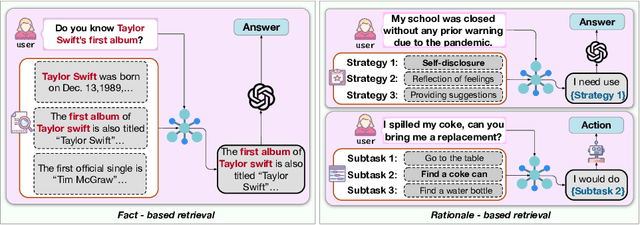
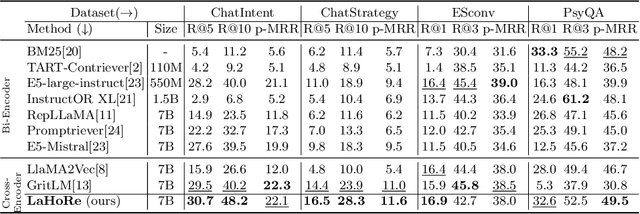


Abstract:Despite the recent advancement in Retrieval-Augmented Generation (RAG) systems, most retrieval methodologies are often developed for factual retrieval, which assumes query and positive documents are semantically similar. In this paper, we instead propose and study a more challenging type of retrieval task, called hidden rationale retrieval, in which query and document are not similar but can be inferred by reasoning chains, logic relationships, or empirical experiences. To address such problems, an instruction-tuned Large language model (LLM) with a cross-encoder architecture could be a reasonable choice. To further strengthen pioneering LLM-based retrievers, we design a special instruction that transforms the retrieval task into a generative task by prompting LLM to answer a binary-choice question. The model can be fine-tuned with direct preference optimization (DPO). The framework is also optimized for computational efficiency with no performance degradation. We name this retrieval framework by RaHoRe and verify its zero-shot and fine-tuned performance superiority on Emotional Support Conversation (ESC), compared with previous retrieval works. Our study suggests the potential to employ LLM as a foundation for a wider scope of retrieval tasks. Our codes, models, and datasets are available on https://github.com/flyfree5/LaHoRe.
KaLM: Knowledge-aligned Autoregressive Language Modeling via Dual-view Knowledge Graph Contrastive Learning
Dec 06, 2024Abstract:Autoregressive large language models (LLMs) pre-trained by next token prediction are inherently proficient in generative tasks. However, their performance on knowledge-driven tasks such as factual knowledge querying remains unsatisfactory. Knowledge graphs (KGs), as high-quality structured knowledge bases, can provide reliable knowledge for LLMs, potentially compensating for their knowledge deficiencies. Aligning LLMs with explicit, structured knowledge from KGs has been a challenge; previous attempts either failed to effectively align knowledge representations or compromised the generative capabilities of LLMs, leading to less-than-optimal outcomes. This paper proposes \textbf{KaLM}, a \textit{Knowledge-aligned Language Modeling} approach, which fine-tunes autoregressive LLMs to align with KG knowledge via the joint objective of explicit knowledge alignment and implicit knowledge alignment. The explicit knowledge alignment objective aims to directly optimize the knowledge representation of LLMs through dual-view knowledge graph contrastive learning. The implicit knowledge alignment objective focuses on incorporating textual patterns of knowledge into LLMs through triple completion language modeling. Notably, our method achieves a significant performance boost in evaluations of knowledge-driven tasks, specifically embedding-based knowledge graph completion and generation-based knowledge graph question answering.
A Practice of Post-Training on Llama-3 70B with Optimal Selection of Additional Language Mixture Ratio
Sep 10, 2024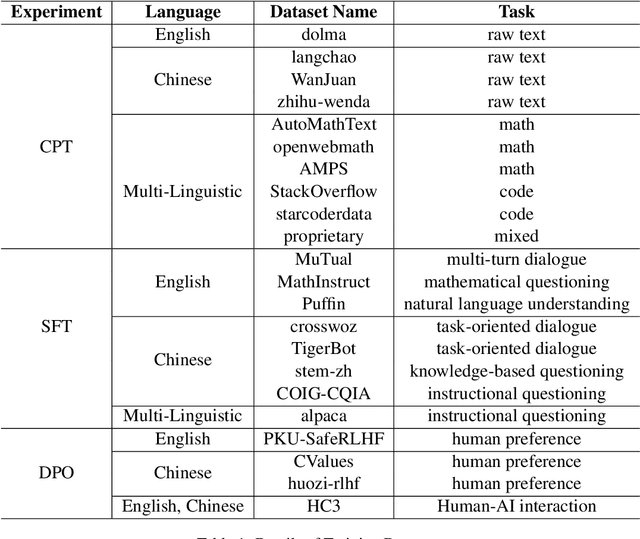
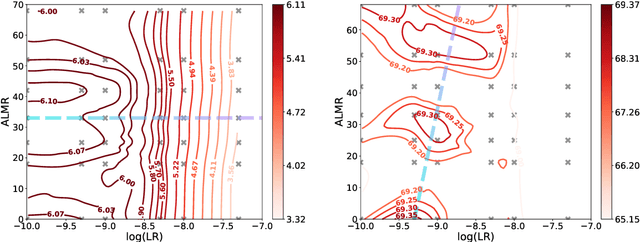
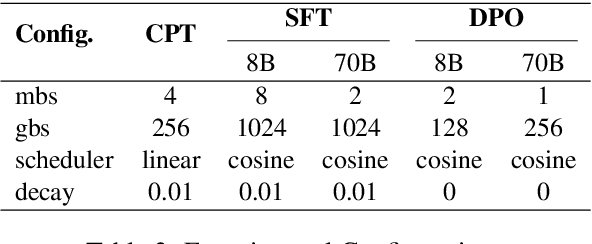
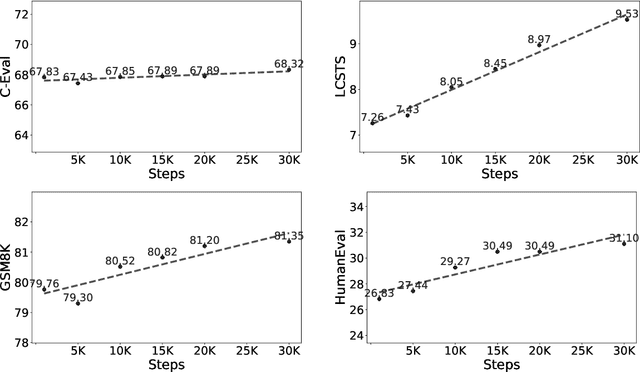
Abstract:Large Language Models (LLM) often needs to be Continual Pre-Trained (CPT) to obtain the unfamiliar language skill or adapt into new domains. The huge training cost of CPT often asks for cautious choice of key hyper-parameters such as the mixture ratio of extra language or domain corpus. However, there is no systematic study which bridge the gap between the optimal mixture ratio and the actual model performance, and the gap between experimental scaling law and the actual deployment in the full model size. In this paper, we perform CPT on Llama-3 8B and 70B to enhance its Chinese ability. We study the optimal correlation between the Additional Language Mixture Ratio (ALMR) and the Learning Rate (LR) on the 8B size which directly indicate the optimal experimental set up. By thorough choice of hyper-parameter, and subsequent fine-tuning, the model capability is improved not only on the Chinese-related benchmark, but also some specific domains including math, coding and emotional intelligence. We deploy the final 70B version of LLM on an real-life chat system which obtain satisfying performance.
LTNER: Large Language Model Tagging for Named Entity Recognition with Contextualized Entity Marking
Apr 08, 2024



Abstract:The use of LLMs for natural language processing has become a popular trend in the past two years, driven by their formidable capacity for context comprehension and learning, which has inspired a wave of research from academics and industry professionals. However, for certain NLP tasks, such as NER, the performance of LLMs still falls short when compared to supervised learning methods. In our research, we developed a NER processing framework called LTNER that incorporates a revolutionary Contextualized Entity Marking Gen Method. By leveraging the cost-effective GPT-3.5 coupled with context learning that does not require additional training, we significantly improved the accuracy of LLMs in handling NER tasks. The F1 score on the CoNLL03 dataset increased from the initial 85.9% to 91.9%, approaching the performance of supervised fine-tuning. This outcome has led to a deeper understanding of the potential of LLMs.
Leveraging Large Language Model for Automatic Evolving of Industrial Data-Centric R&D Cycle
Oct 17, 2023



Abstract:In the wake of relentless digital transformation, data-driven solutions are emerging as powerful tools to address multifarious industrial tasks such as forecasting, anomaly detection, planning, and even complex decision-making. Although data-centric R&D has been pivotal in harnessing these solutions, it often comes with significant costs in terms of human, computational, and time resources. This paper delves into the potential of large language models (LLMs) to expedite the evolution cycle of data-centric R&D. Assessing the foundational elements of data-centric R&D, including heterogeneous task-related data, multi-facet domain knowledge, and diverse computing-functional tools, we explore how well LLMs can understand domain-specific requirements, generate professional ideas, utilize domain-specific tools to conduct experiments, interpret results, and incorporate knowledge from past endeavors to tackle new challenges. We take quantitative investment research as a typical example of industrial data-centric R&D scenario and verified our proposed framework upon our full-stack open-sourced quantitative research platform Qlib and obtained promising results which shed light on our vision of automatic evolving of industrial data-centric R&D cycle.
 Add to Chrome
Add to Chrome Add to Firefox
Add to Firefox Add to Edge
Add to Edge